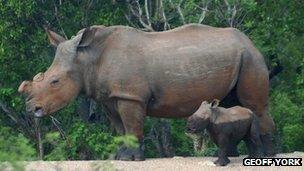Rhino horn DNA database introduced
- Published

Poachers are driven by the high prices paid in China and Vietnam for rhino horn
A new DNA database is being set up to hold genetic information on all the rhinoceros horn in the UK in an attempt to stop its theft and trade.
It's probably not every day that a museum will get a couple of drill bits in the post accompanied by a polite request to bore a hole in one of their highly valuable exhibits.
But those holding rhino horn can expect just such a package in the next few months as the National Wildlife Crime Unit roles out its database.
"The illegal trade in endangered species is one of our six wildlife crime priorities and, within that, the number one issue for us is the illegal trade in rhino horn," says unit head Det Insp Nevin Hunter.
In Africa, white rhino numbers are rising.
But despite this, a rapid rise in the incidence of hunting means that, if present trends continue, it won't be long before the population begins to dwindle.
Poachers are driven by the high prices paid in China and Vietnam for rhino horn - strongly, but wrongly, believed to have powerful medicinal properties.
Stealing antique rhino horn kept in the UK can deliver similar profits with much lower risks.
As one curator in East Anglia said to me: "Thieves fleeing from a county museum are unlikely to get shot."
In the past two years, there have been at least 20 criminal incidents involving rhino horn in the UK and it's not just old trophies at risk - live animals in zoos have been targeted.
PC Andy Long, a wildlife crime officer in Essex who advises Colchester Zoo on keeping its rhinos safe, says it is "highly-organised crime at an international level".
"They know how to obtain the horn and they know how to dispose of it - you can't just sell it on eBay," he says.
Some criminals also try to pass off freshly-poached specimens as antique.
'DIY skills'
The police say precise DNA knowledge will deter thieves, enable officers to secure more convictions and prevent smugglers making bogus claims.
It is part of an emerging effort to use the latest science to push back against smugglers and prevent them cloaking their crimes in the anonymity of their goods.
Ross McEwing, from international forensics service Trace, says: "If we want to make inroads into the illegal trade in endangered species, DNA will certainly be the key tool to do that."
Dr Lucy Webster, who is co-ordinating the government-funded science from a lab outside Edinburgh, usually spends her time investigating DNA at wildlife crime scenes.
But she is now using genetic science as a preventative weapon.
"This is where your DIY skills come in handy," she says.
"We'll be providing museums with a kit with which to take the sample including a 5mm drill bit.
"The shavings of rhino horn contain cellular material that has DNA within it and it's this DNA we will look to isolate to build the individual profiles."
Zoos will be encouraged to gather cheek swabs or blood samples.
The precise technique will be left up to the keepers who know best how to get biological material from their potentially grumpy, two-tonne donor while giving least offence.
At Colchester Zoo, staff stroked Otto the rhino's ear, simultaneously calming the patient, bringing up a vein and slipping in a small syringe.
It didn't appear to interrupt his carrot and apple snack.
Costing the Earth will be shown on Tuesday at 15:30 BST and on Wednesday at 21:00 BST.
- Published30 March 2013
- Published28 February 2013
- Published10 January 2013
- Published10 December 2012